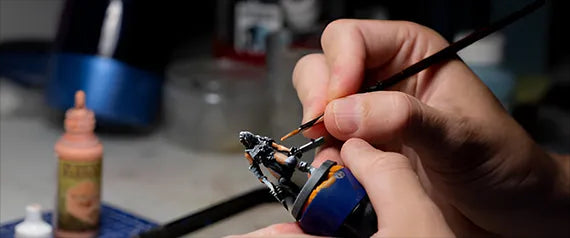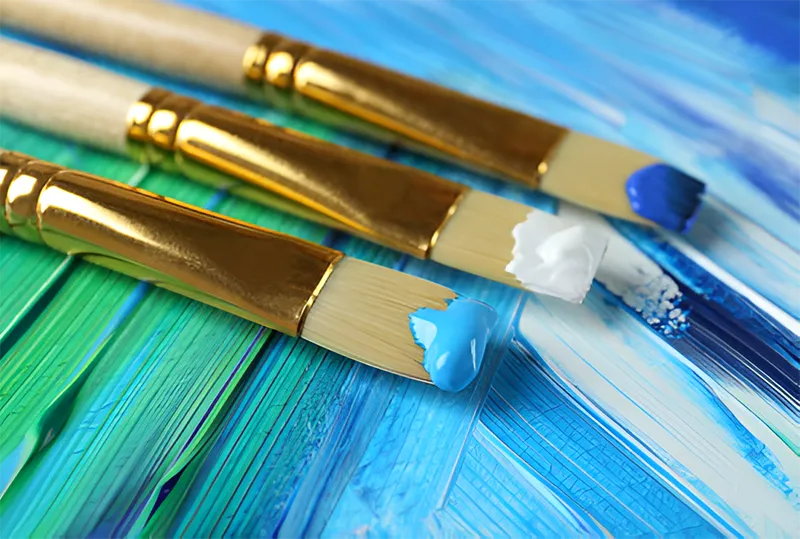Airbrush Vs Paint Brush: Which One Is Better for Model Painting?
Posted by SUNZHUOQIANG

When it comes to painting models and miniatures, hobbyists often debate the merits of using an airbrush versus traditional paintbrushes. Both tools have their strengths and weaknesses, and the choice between them depends on various factors. Let's explore the supplies needed, advantages, and disadvantages of each method to help you decide which is better for your model painting needs.
Supplies Needed for Painting
To those who are now reading this article, if you are starting your first model painting project but are still undecided about which tool to use, it's important to do some preparations and get to know more principles before beginning.
Let's review the basic supplies required for each approach first. In this part, you will know their cost difference and different requirements for use environment.
Tools You Need to Paint with an Airbrush
To get started with airbrushing, you'll need the following equipment:
● Airbrush: A dual-action gravity-fed airbrush is recommended for beginners. This type is now popular among model painting enthusiasts since it allows you to control air and paint separately with paint cup on the top of the airbrush.
● Compressor: An air compressor with a tank and moisture trap is essential. Working pressure of compressor should be compatible with that of airbrush gun.
● Airbrush paints: Specially formulated paints for airbrushing. Acrylic paint is usually used as airbrush paint, please make sure it's thin enough before pour it in paint cup.
● Airbrush thinner: To achieve the right paint consistency.
● Cleaning supplies: Including airbrush cleaner and cleaning brushes. Airbrush needed be cleaned everytime you use it so cleaning supplies are important.
● Respirator or mask: For safety when spraying paint.
● Spray booth or well-ventilated area: To contain overspray and fumes.

Timbertech Airbrush Kit ABPST05
Brush painting requires fewer supplies:
● Various sizes of quality brushes: Including detail, basecoating, and drybrushes.
● Acrylic paints: A range of colors suitable for miniatures.
● Palette: For mixing paints.
● Water pot: For cleaning brushes and thinning paints.
● Paper towels or cloth: For wiping excess paint and cleaning.

Advantages and Disadvantages of Airbrush Painting
Advantages
● Speed: Airbrushing allows for quick basecoating and priming of large areas. If you are planning to paint large-scale models or need to spray the same color on a large area of the model, choose airbrush over brush will save a lot of your time.
● Smooth finishes: Achieves seamless blends and gradients easily since airbrushes break paint down into very fine particles, creating a mist-like spray that allows for thin, even application of paint.
● Consistency: Provides uniform coverage, especially on larger models. The spray pattern of the airbrush can avoid the uneven application that can occur when using brushes. It allows you to apply multiple thin layers of paint, which build up smoothly without visible brush strokes or texture.
● Special effects: Excels at creating OSL (object source lighting) and smooth transitions. You can see airbrush spraying as light and achieve smooth fades and gradients using your airbrush. Airbrush makes it easier if you want to create this kind of impression that a part of the model is glowing.

● Cost: Just as we mentioned in above parts, supplies needed for airbrush painting are more than brush painting. The initial investment for airbrush painting equipment would be higher than brush painting.
● Learning curve: Airbrush painting requires time to master the skills and constant practice, otherwise it may not achieve the desired effect when spraying your model. But once you have mastered the skills, you can not only use it to spray models, but also try other applications such as spraying T-shirts.
● Setup and cleanup: More time-consuming to set up and clean after use. And special care must be taken when cleaning it, otherwise it is easy to damage the airbrush.
● Noise: Compressors can be loud, limiting when and where you can paint.
● Overspray: Can be challenging to control, especially on small details. If you are not used to use it, you may need additional normal airbrushes to paint small details.
● Time-consuming: Painting large areas or basecoating with a brush can be slow and labor-intensive. It requires more time and effort compared to using an airbrush, especially for larger models or multiple miniatures.
● Brush strokes: Brushes can leave visible strokes and texture, especially on smooth surfaces. Achieving a perfectly smooth finish is more challenging with a brush, which can affect the overall look of the model.
● Blending challenges: Creating smooth color transitions and gradients is more difficult with a brush. It requires advanced techniques and patience to achieve seamless blends, which can be time-consuming and difficult for beginners.
● Consistency: Maintaining uniform coverage across multiple models can be harder with a brush. Variability in pressure and paint application can lead to inconsistencies, making it difficult to achieve a uniform look across a collection of models.
● Paint absorption: Brushes can absorb a lot of paint, leading to wastage if not used efficiently. Proper paint thinning and brush loading techniques are essential to minimize waste and achieve the desired results.
● Project scale: For larger models, choose an airbrush over brush can save significant time.
● Detail level: If your focus is on intricate details or if you are trying to paint miniatures, brush painting might be preferable.
● Budget: Consider your initial investment capacity and long-term hobby goals. If your initial budget is sufficient, you can use the combination to improve your model painting efficiency.
● Space and noise constraints: Ensure you have a suitable area for airbrushing and make sure you can accept compressor you can accept the slight noise the compressor makes when working. Otherwise, you can only choose brush to paint your model.

